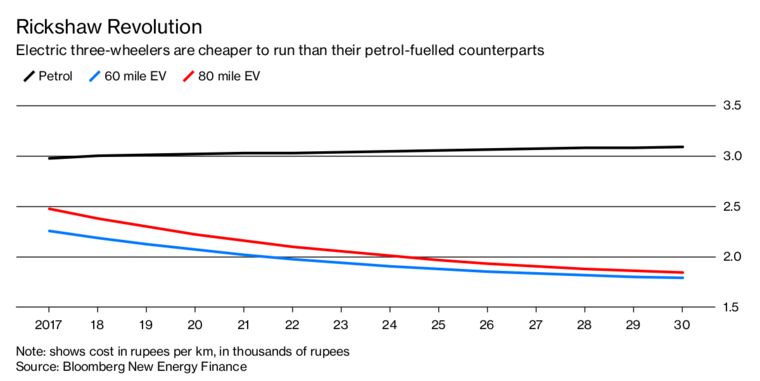› Forums › General › News (General) › India’s Rickshaw Revolution Leaves China in the Dust
Tagged: energy_O4, SmartCity_V5b, Transport_V9
- This topic has 0 replies, 1 voice, and was last updated 6 years, 2 months ago by
TelegramGroup IoTForIndia.
-
AuthorPosts
-
-
November 1, 2018 at 5:44 am #26092
#News(General) [ via IoTForIndiaGroup ]
An electric-vehicle revolution is gaining ground in India, and it has nothing to do with cars.
The South Asian nation is home to about 1.5 million battery-powered, three-wheeled rickshaws – a fleet bigger than the total number of electric passenger cars sold in China since 2011. But while the world’s largest auto market dangled significant subsidies to encourage purchases of battery-powered cars, India’s e-movement hardly got a hand from the state.
Rather, drivers of the ubiquitous three-wheelers weaving through crowded, smoggy streets discovered that e-rickshaws are quieter, faster, cleaner and cheaper to maintain than a traditional auto rickshaw. They also are less strenuous than cycle rickshaws, which require all-day peddling. So with more rides possible in a day, the e-rickshaws are proving more lucrative.
As many as 11,000 new e-rickshaws hit the streets every month, and annual sales are expected to increase about 9 percent by 2021, according to Rahul Mishra, a principal at consulting firm A.T. Kearney. Three-wheeled vehicles make up a $1.5 billion market, and manufacturers of electric versions include Mahindra & Mahindra Ltd. and Kinetic Engineering Ltd., along with smaller outfits that assemble parts imported from China.
“This is a once-in-a-lifetime, transformational opportunity that we’re looking at,’’ said Goldie Srivastava, chief executive officer and co-founder of SmartE, an Uber-style app using 800-plus e-rickshaws around New Delhi. “When we look at electric mobility, the focus should be: Are you as a government enabling products that are designed for the future?’
Unlike the estimated 1.35 million passenger EVs cruising around China, the number of electric cars plying Indian roads is a paltry 6,000, according to BNEF data. Chinese automakers sell more than that in three days.
A total of 635,698 three-wheel vehicles were sold during the fiscal year that ended in March – a 24 percent increase from a year earlier, according to the Society of Indian Automobile Manufacturers. By comparison, about 3.3 million passenger cars were sold, mostly all powered by gasoline or diesel.One hindrance to the potential growth of EVs is the lack of charging and battery-swapping stations nationwide. India had about 425 publicly available charging points at the end of last year. By 2022, government and private efforts are expected to boost that to an estimated 2,800 charging points, according to BNEF.
-
-
AuthorPosts
- You must be logged in to reply to this topic.
